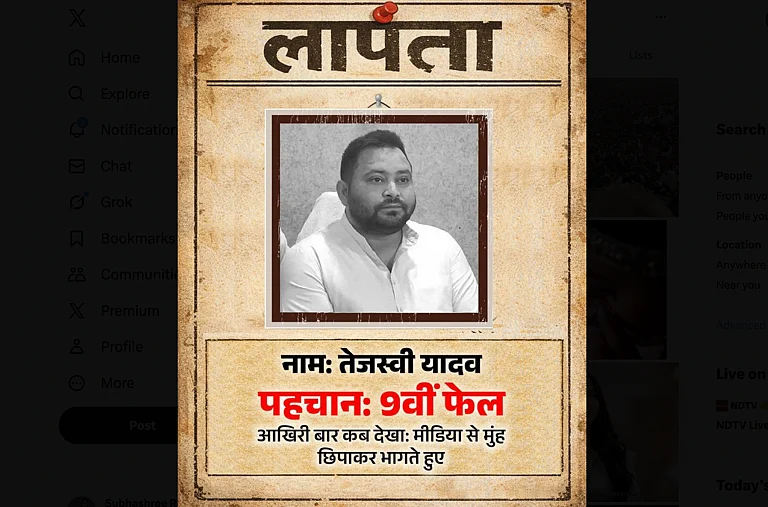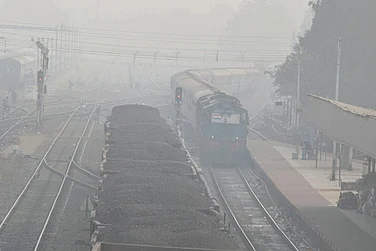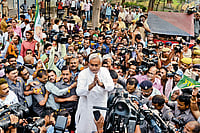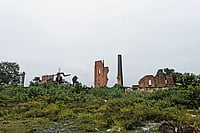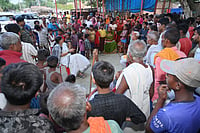On October 7, 1992, violent riots took place in Sitamarhi district of Bihar, officially killing about 40 people. This was the second gruesome riot after the Bhagalpur riots in 1989 when the Congress was in power in the State. Sitamarhi riots were triggered by a religious procession which defied the agreed route and passed through minority-concentrated areas. The then DM of Sitamarhi was horrified and he immediately informed A.K. Biswas, the then commissioner of Tirhut Division, on the phone. A.K. Biswas contacted the then home secretary Jia Lal Arya and informed him about the incident and said that Chief Minister Lalu Prasad Yadav and the chief secretary should also be told about it.
Biswas rushed to the riot-affected areas along with other officers. About an hour-and-a-half after he reached the affected site, Lalu Prasad Yadav landed at Sitamarhi in a helicopter. He would monitor the riot situation from circuit houses and get the latest developments every few minutes. After about three hours, A.K. Biswas met Lalu Prasad Yadav and gave him the full details of the incident and steps taken. Lalu Prasad Yadav seemed satisfied with this and he gave Biswas a free hand to take whatever action was needed. Lalu Prasad Yadav himself remained in Sitamarhi for a whole day.
He also visited some riot-affected areas and gave instructions to run relief work on a war footing. After this, he returned to Patna, but for the next three days, he kept going to Sitamarhi intermittently. The Lalu government constituted a special court for the speedy trial of the Sitamarhi riots, where the culprits were punished within a year. This was a rare gesture from any government and Lalu was hailed for his swift action.
In his book Secularism: Concept and Practice, writer A.K. Lal notes, “This was probably the first time in the judicial history of the country that the procedure of investigation, submission of charge sheet, conclusion of trial and delivery of judgment were completed within about one year.”
Lalu Prasad Yadav became chief minister in 1990. At that time, he was with Janata Dal (JD). Later, in 1997, he broke with JD and formed his own party, Rashtriya Janata Dal (RJD). Between 1990 to 2005, Bihar was ruled by Lalu Prasad Yadav and his wife Rabri Devi, but except for the Sitamarhi riots, there was no major communal violence except some minor incidents.
Even on December 6, 1992, when karsevaks demolished the Babri Masjid in Ayodhya, the whole country was engulfed in riots, but Bihar did not witness any major communal riots except a minor incident of violence in Lohardaga (now in Jharkhand). It was perhaps the aggressive stance of Lalu Prasad Yadav against communalism that saved Bihar from the clutches of communal fanaticism.

Lalu Stops Advani’s Rath
The root of Lalu’s aggressive attitude against communalism goes back to October 22, 1990. The situation was tense in the country as BJP leader L.K. Advani was leading a Rath Yatra which was supposed to reach Ayodhya. Lalu Prasad Yadav received a message from then Prime Minister V.P. Singh–he would have to arrest L.K. Advani in Bihar. Lalu agreed and immediately formed a disaster management squad to control any untoward situation. On October 22, 1990, L.K. Advani was arrested in a covert operation in Samastipur and sent back to Delhi. This made Lalu Yadav the tallest secular leader who dared to arrest L.K. Advani.
Rise of Mandal Politics
In Bihar, Lalu Prasad Yadav was crowned with the votes of Other Backward Castes (OBCs) and Dalits. Coming from a poor family background, Lalu was the sixth backward leader who had become chief minister after Bhola Paswan Shastri, B.P. Mandal, Daroga Rai, Ram Sundar Das and Karpuri Thakur but unlike others, he vocally projected himself as the representative of backward society and secured the backward caste vote. He would often say that he was there to protect backward-caste people and they need not fear the upper castes. This gave backward class people and Dalits a sense of security and they became his vote bank. It was further strengthened by the Mandal Commission’s recommendation of 27 per cent reservation to OBCs in government jobs and education. It was implemented in August 1990 by V.P. Singh on the advice of Lalu Prasad Yadav. Experts believe that after the implementation of the Mandal Commission recommendations, politics changed in Bihar. Backward classes started pressing their caste identity over their Hindu identity which weakened the BJP’s Hindutva politics and strengthened the vote bank of socialist Lalu Prasad Yadav. It was at this very time that the mandal versus kamandal discourse entered Bihar politics. The political connotation of the word ‘mandal’ is social justice and that of ‘kamandal’ is Hindutva. Patna-based journalist Chandan says, “Lalu comes from the Yadav caste, which falls under the OBC community, so when he became the chief minister he made himself the representative of Dalits and OBCs. He used to go to Dalit settlements and eat food from a Dalit’s plate. He came across as one of their own. This gave him a strong hold on Dalits and backwards.”
Mandal 2.0 in the Making
Despite raising the emotive issue of the Ram temple in Ayodhya, the BJP remained on the backfoot in Bihar, until it joined hands with Nitish Kumar. Although the BJP enjoyed power after this, the upper hand remained with Nitish Kumar and the role of the saffron party was that of junior partner. Nitish Kumar also maintained secularism to a large extent. But he would not express his views strongly on communalism like Lalu.
In politics, even if two parties come together to run the show, there remains the hidden effort of damaging the partner and strengthening itself. The BJP did this meticulously. Apart from this, the saffron party realised the importance of OBC and Dalit votes and appointed backward leaders to important posts and even gave tickets to them. It slowly strengthened its base. In the 2020 State Assembly elections, the BJP emerged as the second largest party winning 74 seats, just one seat less than Rashtriya Janata Dal (RJD). Now that almost nine years of the BJP government at the Centre have been completed and the party is desperately polarising voters on the basis of religion across the country, its effect is being seen in Bihar as well.
Incidents of communal violence have increased in Bihar in recent times. In the last 6-7 months, two Muslims have been killed on suspicion of carrying beef. In April this year, Nalanda and Rohtas, witnessed riots and arson. Incidents of communal tension took place in at least five districts of Bihar in the last week of July and Internet service had to be suspended in four districts.
With the strengthening foothold of the saffron party, it seems RJD and JDU are trying to invoke Mandal 2.0. It is believed that the ongoing caste census in Bihar is a part of this effort. Both RJD and JDU are sure that the caste census will be a new chapter in Bihar politics, which will benefit them and damage the prospects of the BJP.
Political analysts believe that only social justice can be the antidote to radical Hindutva and the caste census can prove to be a strong step in this direction.










